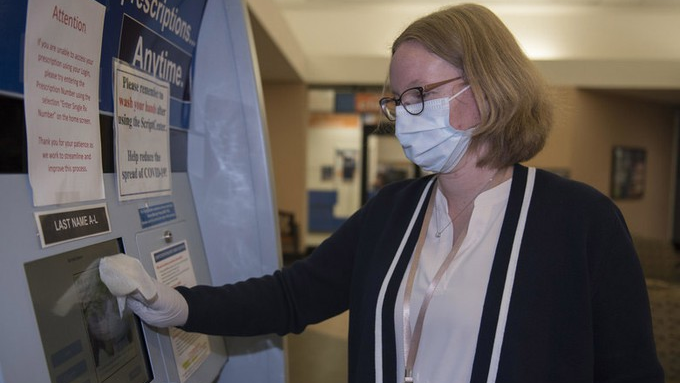
Jacqueline Bradford, an office assistant at Travis Air Force Base, disinfects a kiosk at a testing site in March. The state promises to be delivering 10,000 tests per day by the end of April. U.S. Air Force photo by Airman 1st Class Cameron Otte
Life in California has ground to a near standstill since the advent of the novel coronavirus and COVID-19. While heath care workers and public officials fight a global pandemic that had more than 35,000 known cases and 1,300 deaths in California as of April 22, more than 2 million residents had filed for unemployment benefits and much of the state continued to follow a stay-at-home order issued March 19 by Gov. Gavin Newsom.
When he announced the plan to gradually get people back out into the world at a press conference, he told reporters: “It will not be a permanent state."
Newsom outlined six indicators that will guide the state in its lifting of the stay-at-home order in the weeks to come. These indicators are as follows:
1. Testing, contact tracing, isolating, and supporting people exposed or positive.
Testing remains low in California, with just over 300,000 tests administered as of April 22 in a state of approximately 40 million people. California Health and Human Services Secretary Dr. Mark Ghaly said during an April 14 press conference that he hopes to have tens of thousands of tests per day by the end of April “not just for the sickest, but all throughout.
2. Preventing infection in more at-risk patients
COVID-19 poses heightened risks for the elderly and people with underlying conditions, with a roadmap posted online by state lawmakers stressing the importance of determining if people in these groups who live alone are supported and if quick interventions are available for where these people live in group settings.
3. Capability of hospitals to handle surges
Fast Company pointed out in March that California has the fifth-lowest number of hospital beds-per-resident nationally, with just 1.8 for every 1,000 people. The state has worked with the U.S. Army Corps of Engineers to rapidly get eight new field hospitals up and running, with Newsom saying two weeks ago that California would need 70,000 more hospital beds and that the number of critical care patients would climb to 27,000 by mid-May.
Officials called Tuesday for assessing if hospitals had sufficient beds, staff, and personal protective equipment. They also urged assessing if health systems were equipped to deal with COVID-19 and still be able to deal with other health care needs, some of which haven’t been addressed amidst the crisis, with elective surgeries being postponed.
4. Development of therapeutics
Plans released Tuesday included urging creation of a coalition of public, private, and academic partners to increase the speed of therapeutic development and having ways in the future to gauge if promising therapeutics were being identified.
5. Businesses, schools, and child-care facilities being able to support social distancing
In terms of number of cases per residents, California has been far from the hardest-hit part of the country for COVID-19, with officials including Dr. Sonia Angell praising the diligent work by residents. “We’ve really started to, so to speak, bend the curve,” Angell told reporters, though she added that the state can’t just look to send people back into the streets. Accordingly, the state will look to continue social distancing in businesses, with officials saying restaurants are likely to have fewer tables, and that face masks will be common. Distancing could remain a fact of life for children, too, the governor said, adding that “The area we will be building out much more robustly is the school space.”
6. Knowing when to reinstitute stay-at-home orders, where necessary
Newsom spoke of the hope for California to shift from surge to suppression against COVID-19, “to herd immunity and ultimately a vaccine.”
But with a vaccine possibly taking as long as 18 months, officials conceded Tuesday that stay-at-home orders might need to be reinstituted after being relaxed, and that key questions include seeing if the right data is being tracked to provide an early warning system, and if the state has quick communications ability when stay-at-home orders are reinstituted.
More info can be found at covid19.ca.gov.
Long form articles which explain how something works, or provide context or background information about a current issue or topic.